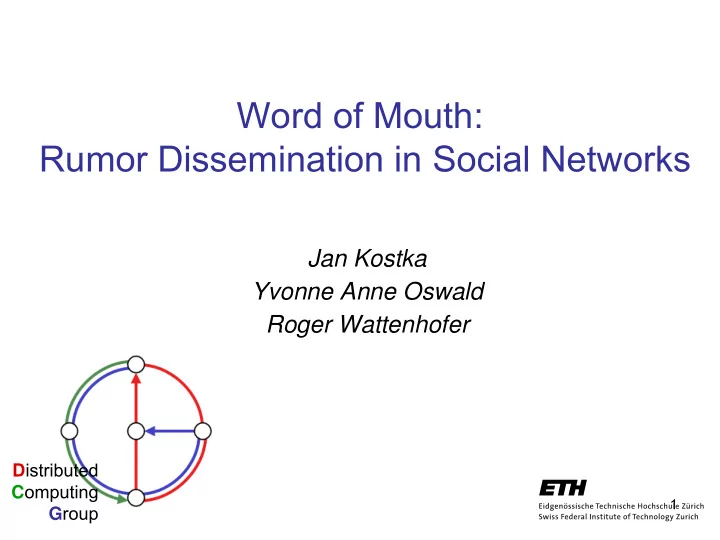

Word of Mouth: Rumor Dissemination in Social Networks Jan Kostka Yvonne Anne Oswald Roger Wattenhofer D istributed C omputing 1 G roup
Introduction social networks everywhere: facebook, co-authors, email .... => effects dissemination of information => influences decisions Windows or Mac? Yvonne Anne Oswald @ SIROCCO 2008 2
Introduction social networks everywhere: facebook, co-authors, email .... => effects dissemination of information => influences decisions Windows or Mac? • viral marketing • competing theses, theories • virus vs immunisation GOAL: select optimal initiator set, to convince as many nodes as possible Yvonne Anne Oswald @ SIROCCO 2008 3
Related Work 1 rumour • epidemics, physical processes: sophisticated propagation models + simulation • Kempe et al. [KDD03] : selecting optimal initiators is NP-hard greedy hill climbing algorithm: (1-1/e)-approximation 2 competing rumours • Bharati et al.[WINE07], Carnes et al.[ICEC07] 2nd player: selecting optimal initiators is NP-hard hill climbing works as well 1st player What about the 1st player? Yvonne Anne Oswald @ SIROCCO 2008 4
Basic Model • strategy: select set of nodes to initiate the rumour Payoff: • rumour propagation: # convinced accept first rumour encountered nodes forward rumour to all adjacent nodes Example 1 st player: 4 nodes 2 nd player: 3 nodes variations: more players, payoff definition, propagation model (cascade, threshold, …), weighted or directed edges, … Yvonne Anne Oswald @ SIROCCO 2008 5
Warm-Up: 1 vs 1 • Complete graph • Trees • Grid • Bottleneck Yvonne Anne Oswald @ SIROCCO 2008 6
He who laughs last, laughs best? Intuition: 1st player has more choice ⇒ better chance to win There are networks where the 1st player always loses!!! (computational power irrelevant) Yvonne Anne Oswald @ SIROCCO 2008 7
How hard is it to compute the optimal strategy? Centroid Problem 1st player: how do I choose the optimal starting set? (knowing how many nodes the second player can select) ? ? ? ? ? ? ? Medianoid Problem ? 2nd player: how do I choose my optimal starting set? (knowing the nodes selected by the 1st player) ? ? ? ? ? ? ? Yvonne Anne Oswald @ SIROCCO 2008 8
NP-hardness of Medianoid Problem Theorem. The (r|p)-medianoid problem is NP-hard. Proof: Reduce Dominating Set (DS) problem to (r|1)-medianoid problem. Idea: show that ∃ Y r s.t. 2nd player wins 1st player chooses x 1 2nd player selects Y r at least |V|+r nodes <=> ∃ DS with r nodes payoff 2nd player: # nodes closer to Y r than to X p . Y r = DS Yvonne Anne Oswald @ SIROCCO 2008 9
NP-hardness of Medianoid Problem Theorem. The (r|p)-medianoid problem is NP-hard. Proof: Reduce Dominating Set (DS) problem to (r|1)-medianoid problem. 1st player chooses x 1 2nd player selects Y r payoff 2nd player: # nodes closer to Y r than to X p . Y r != DS Yvonne Anne Oswald @ SIROCCO 2008 10
NP-hardness of Centroid Problem Theorem. The (r|p)-centroid problem is NP-hard. Proof: Reduce Vertex Cover (VC) problem to (1|p)-centroid problem. Given graph G(V,E), replace each edge with “diamond structure” Idea: show that “<=” V’ solution to VC problem, let X p = V’ ∃ X p s.t. less than 2 2 nd player wins ≤ 2 nodes closer to Y 1 ( X p ) <=> “=>“ ∃ VC with p nodes 2 nd player wins ≤ 2 1st player chooses X p 2nd player selects Y 1 ( X p ) if x i on every diamond, we are ok if no x i on diamond, contradiction Yvonne Anne Oswald @ SIROCCO 2008 11
NP-hardness of Approximating the Centroid Problem Theorem. Computing an α -approximation of the (r|p)-centroid problem is NP-hard. Proof: Reduce Vertex Cover (VC) problem to (1|p)-centroid problem. Given graph G(V,E), replace each edge with “clique structure” same idea, a little bit more Y_1(X_p) := node complicated 4 α -2 Yvonne Anne Oswald @ SIROCCO 2008 12
More findings… • relationship Condorcet vertex – centroid • characterize weaknesses of heuristics for centroid • small radius • high degrees • midpoint of spanning tree • (not in paper) simulation of strategies in random graphs: Kleinberg, Watts, Epstein model Yvonne Anne Oswald @ SIROCCO 2008 13
The End! Thank Thank you! you! Questions? Comments? Yvonne Anne Oswald @ SIROCCO 2008 14
Recommend
More recommend